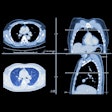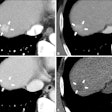An abnormal CT angiography (CCTA)-derived fractional flow reserve (CT-FFR) result may translate to up to seven years of increased cardiovascular risk -- rather than the originally understood three years, researchers have reported.
As the prognostic value of CT-FFR has been unclear, this study's findings offer further insight, wrote a team led by Kristian Tækker Madsen, MD, of University Hospital of Southern Denmark in Esbjerg. The results were published October 14 in Radiology.
"We observed that an abnormal CT-FFR remained associated [beyond three years] with a significantly increased risk of cardiovascular death or spontaneous myocardial infarction compared with a normal CT-FFR, both in the overall cohort and in participants with high coronary artery calcium scores [CAC]," the group noted.
This analysis built on three-year outcome data from 900 Danish individuals who participated in the Assessing Diagnostic Value of Non-invasive CT-FFR in Coronary Care (ADVANCE-DK) trial. The trial consisted of a study period between December 2015 and October 2017 and included participants from three Danish centers with an initial onset of stable angina and at least one coronary stenosis of at least 30% on CCTA imaging. ADVANCE-DK defined abnormal CT-FFR as a value of 0.8 or less than two centimeters distant from stenosis, and high CAC as a score of at least 400 (of the 900 patients, 42% had abnormal CT-FFR results and 44% had high CAC scores). The ADVANCE-DK researchers obtained coronary plaque analysis information from an AI algorithm and set the study's endpoint as a composite of cardiovascular death or spontaneous myocardial infarction.
For this study, Madsen and colleagues investigated whether the CT-FFR test result would be associated with longer-term risk of adverse cardiovascular outcomes, both overall and in a subset of patients with high CAC scores, with a mean follow-up time of seven years rather than three.
They found the following:
- Over the seven-year follow-up period, 41 cardiovascular deaths and 39 spontaneous myocardial infarctions were noted, resulting in 77 of the 900 (8.6%) participants reaching an end point.
- Those participants who experienced cardiovascular death or myocardial infarction had higher CAC scores (median, 511 versus 284 respectively; p = 0.001) and higher total plaque volumes compared to those who did not (median, 624 versus 427 respectively; p = 0.002) compared with participants who did not.
- The adverse cardiovascular event rate was similar for individuals with a stenosis greater than 50% versus those with a stenosis of 50% or less at CCTA (59 of 730 [8%] versus 14 of 150 [9%]; p = 0.63).
- Cardiovascular death or myocardial infarction occurred more frequently in patients with abnormal CT-FFR results compared to those with normal results (12.5% versus 5.7%, with a hazard ratio [HR] of 2.54; p < 0.001).
- Cardiovascular death or myocardial infarction occurred more frequently in patients with high CAC scores (13.2% versus 8.2% with an HR of 1.88; p = 0.04).
- An abnormal CT-FFR result remained associated with increased risk of cardiovascular death or myocardial infarction when the researchers adjusted for stenosis severity, CAC score, and statin adherence (HR, 2.18; p = 0.004) and when adjusted for stenosis degree, total plaque volume, and statin adherence (HR, 2.21; p = 0.005).
This analysis of ADVANCE-DK data underscores the need for further research, according to the authors.
"Notably, following 3.5 years of follow-up, events started to steadily accrue in the normal CT-FFR group," they concluded. "Whether this change in event rate represents the development of high-risk plaque morphologic characteristics or a progression toward abnormal CT-FFR across time … remains unknown and requires further investigation in future studies."
The complete study can be found here.





















